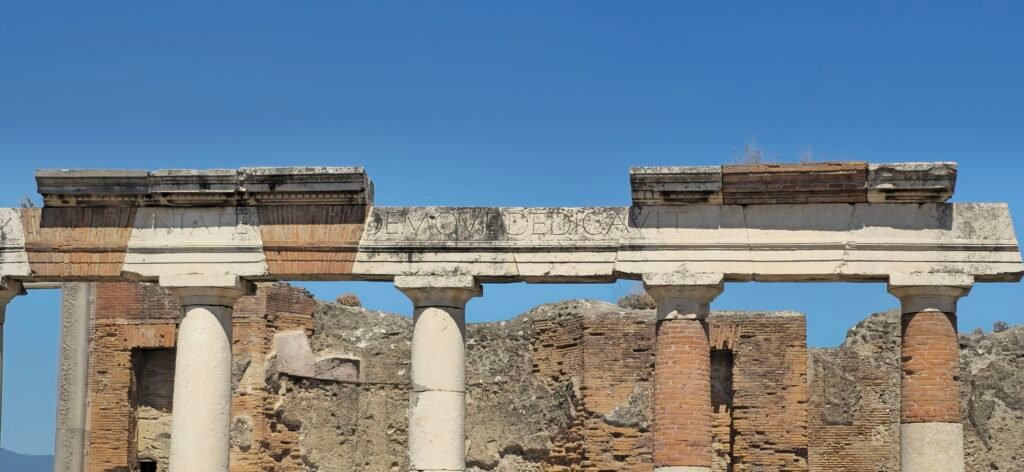Stepping onto the ancient, uneven stone streets of Pompeii is an experience unlike any other. It’s a moment where history isn’t just a lesson in a book; it’s the air you breathe, the stones beneath your feet, and the shadow of Mount Vesuvius looming in the distance – a constant, stark reminder of the city’s dramatic end. This isn’t just a ruin; it’s a preserved snapshot of Roman life, dramatically frozen in time by the eruption of 79 AD.
Planning a visit to this UNESCO World Heritage site can feel daunting because of its sheer size and depth of history. But with a little preparation, you can turn a simple day trip into an unforgettable journey through a lost world.
The Genius of Roman Urban Planning
As you wander through Pompeii, pay close attention to the city’s infrastructure. The streets themselves tell a story of advanced urban planning. They are primarily narrow, paved with large, dark basalt stones worn smooth by countless chariots and footsteps. You’ll notice deep ruts carved into the stone, evidence of the constant flow of traffic.
One of the most fascinating features is the ancient Roman equivalent of crosswalks: raised stepping stones. These large, strategically placed blocks allowed pedestrians to cross the street without stepping into the often-muddy or sewage-filled roadways. The gaps between the stones were perfectly spaced to accommodate the wheels of chariots, allowing them to pass through unimpeded. These stepping stones are not just historical curiosities; they are a testament to Roman ingenuity in managing urban life and traffic flow, truly an ancient solution to a modern problem.
Essential Sightseeing: What Not to Miss
Pompeii is vast, and you could easily spend a whole day here. If you’re short on time, here are the absolute must-sees that bring the city to life:
- The Forum (Foro): The beating heart of Pompeii—its main piazza, market, and administrative center.
- The Amphitheater (Anfiteatro): One of the oldest surviving Roman amphitheaters, where gladiator contests once roared.
- The Stabian Baths: A complex and well-preserved example of Roman public life, showcasing bathhouse culture.
- Residential Homes: Look for the famous mosaic of the watchdog, ‘Cave Canem’ (“Beware of Dog”), and the magnificent frescoes at the House of the Vettii.
- Garden of the Fugitives (Orto dei Fuggiaschi): A haunting and powerful area displaying the plaster casts of victims who perished trying to escape.
Your Practical Pompeii Prep Kit
To make your experience comfortable and maximize your time, heed these practical tips:
- Wear the Right Shoes: The ancient roads are uneven basalt stones. Seriously, skip the sandals and wear your most comfortable, sturdy walking shoes!
- Hydrate and Protect: Pompeii offers minimal shade. Sunscreen and a Hat are non-negotiable. Bring a Reusable Water Bottle—you can safely refill at ancient fountains across the site.
- Get a Guide (or an Audio Guide/Map): The site is huge. A local guide or an audio guide provides essential context and helps you navigate efficiently.
- Buy Tickets in Advance: Pre-purchasing your ticket online will help you bypass the often-long lines at the gate.
- Mind the Bag Size: Large bags and backpacks (typically over 30 \times 30 \times 15 cm) are not allowed inside and must be checked.
How to Get There from a Cruise Ship (Naples Port)
If your cruise ship docks in Naples, getting to Pompeii is relatively straightforward:
- Walk to the train station (Napoli Garibaldi/Piazza Garibaldi): From the cruise terminal, make your way to the lower level of Napoli Centrale, following signs for the local Circumvesuviana line.
- Take the Circumvesuviana Train: Look for the train heading towards Sorrento. The ride takes about 30-40 minutes.
- The Stop: Get off at “Pompei Scavi – Villa dei Misteri.” The station is directly across the street from the main archaeological entrance (Porta Marina Superiore).
- Shore Excursions: For maximum convenience, many cruise lines offer organized tours with direct transfers and guides, eliminating the need for public transport navigation.
The Best Time to Go
Timing is everything in Pompeii:
- Shoulder Seasons (April-May & September-October): These are the ‘sweet spots.’ The weather is pleasantly warm, ideal for walking, and the crowds are more manageable.
- Early Morning or Late Afternoon: Arriving right at opening time (8:30 AM) or visiting after 3 PM will help you beat the midday heat and the largest tour groups. The late afternoon light is particularly evocative for photos.
Pompeii is more than just a place to see; it’s a place to feel. It’s a profound connection to the past, reminding us of the fragility of life and the incredible resilience of history. Prepare well, and enjoy walking with the ghosts of Ancient Rome.

